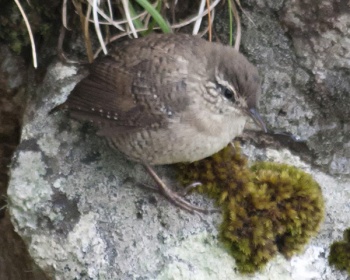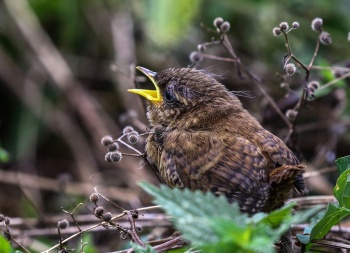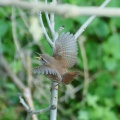Sbarnhardt (talk | contribs) (Removed Video search - No longer operable) |
Sbarnhardt (talk | contribs) (Add jbpixels Displaying image to Habitat) |
||
| (4 intermediate revisions by 2 users not shown) | |||
| Line 2: | Line 2: | ||
;[[:Category:Troglodytes|Troglodytes]] troglodytes | ;[[:Category:Troglodytes|Troglodytes]] troglodytes | ||
==Identification== | ==Identification== | ||
| − | [[Image: | + | [[Image:1-06-S64A6619-2.jpg|thumb|350px|right|Fledgling, subspecies ''indigenus''<br />Photo © by {{user|max1|max1}}<br />[[Lakenheath Fen]], [[Suffolk]], August 2019]] |
Length is 9-10 cm (3½-4 in), weight 6-12 g. | Length is 9-10 cm (3½-4 in), weight 6-12 g. | ||
*Mostly brown, in most populations with a reddish tint | *Mostly brown, in most populations with a reddish tint | ||
| Line 11: | Line 11: | ||
*Bill slightly down curved | *Bill slightly down curved | ||
====Variations==== | ====Variations==== | ||
| + | [[Image:Winter_Wren.jpg|thumb|350px|right|Subspecies ''T. t. indigenus'' <br />Photo © by {{user|Steve+Round|Steve Round}}<br />Wirral, [[Cheshire]], [[England]], July 2004]] | ||
Island populations tends to be larger birds than continental populations. For example in [[Iceland]] and the [[Faroe Islands]], wings, legs, and bill are longer than in the UK. | Island populations tends to be larger birds than continental populations. For example in [[Iceland]] and the [[Faroe Islands]], wings, legs, and bill are longer than in the UK. | ||
==Distribution== | ==Distribution== | ||
| Line 55: | Line 56: | ||
==Habitat== | ==Habitat== | ||
| + | [[File:Eurasian-Wren_Displaying_JBPXL.jpg|thumb|350px|right|Displaying<br />Photo © by {{user|jbpixels|jbpixels}}<br />Munich, [[Germany]], 5 April 2024]] | ||
Can be found in almost any habitat, low down in undergrowth from gardens and woodland to clifftops. | Can be found in almost any habitat, low down in undergrowth from gardens and woodland to clifftops. | ||
==Behaviour== | ==Behaviour== | ||
| − | |||
Tends to keep low when flying. | Tends to keep low when flying. | ||
====Diet==== | ====Diet==== | ||
| Line 86: | Line 87: | ||
{{ref}} | {{ref}} | ||
==External Links== | ==External Links== | ||
| − | {{GSearch|"troglodytes troglodytes"}} | + | {{GSearch|"troglodytes troglodytes" {{!}} Eurasian Wren"}} |
| + | {{GS-checked}}1 | ||
| + | <br /> | ||
<br /> | <br /> | ||
| − | [[Category:Birds]] [[Category:Troglodytes]] [[Category:Nannus | + | [[Category:Birds]] [[Category:Troglodytes]] [[Category:Nannus]] [[Category:Bird Songs]] |
Latest revision as of 13:40, 16 April 2024
- Troglodytes troglodytes
Identification
Length is 9-10 cm (3½-4 in), weight 6-12 g.
- Mostly brown, in most populations with a reddish tint
- Barred wing and tail feathers
- Small tail (often cocked)
- Pale buff underside (some populations almost as dark as the back)
- Prominent pale supercilium
- Bill slightly down curved
Variations
Island populations tends to be larger birds than continental populations. For example in Iceland and the Faroe Islands, wings, legs, and bill are longer than in the UK.
Distribution
In Europe from Iceland to central Scandinavia and south to the Mediterranean.
In Asia, it is widely distributed from north to south in the eastern end, but in central Asia, there is a gap separating those populations from western Asian and European populations.
Taxonomy
Was formerly considered conspecific with Winter Wren and Pacific Wren, but the three were split on the basis of vocal and genetic evidence[1][2].
Rice et al (1999) proposed placing these species in a separate genus, Nannus3. Later molecular studies support this classification, because the closest relatives of Eurasian Wren, Winter Wren and Pacific Wren are not other members of the genus Troglodytes, but the Marsh and Sedge Wrens4, though this classification has not been followed by any of the main authorities[5][6].
Subspecies

Heavier barring, greyer (less rufus) plumage and stockier body than mainland species
Photo © by Bert Swan
Seen on 430 metre cliff, Hirta, St Kilda, Outer Hebrides, Scotland

Photo © by Mark Bruce
Anmashan, Taichung County, Taiwan, December 2008
A high alpine subspecies found in forest undergrowth between 2000m-3400m
A total of 28-29 subspecies are accepted[5][6]:
- T. t. islandicus: Iceland
- T. t. borealis: Faroe Islands (north Atlantic Ocean)
- T. t. zetlandicus: Shetland Islands (Scotland)
- T. t. fridariensis: Fair Isle (Scotland)
- T. t. hirtensis: St Kilda (Scotland)
- T. t. hebridensis: Outer Hebrides (Scotland)
- T. t. indigenus: Ireland, and Great Britain apart from islands above
- T. t. troglodytes: Continental Europe and Asia Minor
- T. t. kabylorum: Balearic Islands, southern Spain and north-western Africa (Morocco to Tunisia)
- T. t. koenigi: Corsica and Sardinia
- T. t. juniperi: Northwestern Libya
- T. t. cypriotes: Crete, Rhodes, Cyprus and Near East
- T. t. hyrcanus: Crimean Peninsula to Caucasus Mountains, northern Iraq and Iran
- T. t. zagrossiensis: Western Iran (not considered distinct by all authorities[5])
- T. t. tianschanicus: Northeastern Iran and southern Transcaspia to northern Afghanistan and Turkestan
- T. t. subpallidus: Himalaya of Afghanistan
- T. t. magrathi: Mountains on borders of Pakistan and Afghanistan
- T. t. neglectus: Western Himalaya (Gilgit to western Nepal)
- T. t. nipalensis: Himalaya of Nepal to north-eastern Assam and southern Tibet
- T. t. idius: Northern China (south Hebei to Shandong)
- T. t. szetschuanus: Western China (southern Shaanxi and Sichuan east to Hupei)
- T. t. talifuensis: Southwestern China (southern Sichuan to western Yunnan) and northeastern Burma
- T. t. dauricus: Eastern Siberia to Sakhalin, Manchuria and Korea
- T. t. pallescens: Kamchatka Peninsula and Komandorskiye Islands
- T. t. kurilensis: Northern Kuril Islands (Shasukotan and Ushichi)
- T. t. fumigatus: Southern Kuril Islands and Japan
- T. t. mosukei: Izu Islands and Daito Islands
- T. t. ogawae: Southern Japanese Archipelago (Tanegashima and Yakushima)
- T. t. taivanus: Taiwan
Habitat
Can be found in almost any habitat, low down in undergrowth from gardens and woodland to clifftops.
Behaviour
Tends to keep low when flying.
Diet
Forages under dense cover for small insects and spiders.
Breeding
The nest is a ball of grass, leaves or other vegetation and may be placed in a bank hole, in thick vegetation or tucked under overhang. The clutch consists of 5-8 white eggs with brownish-red speckles. They are incubated for about 2 weeks and fledge around 16 or 17 days later.
There are usually 2 broods in the season which runs from April to August.
Vocalisation
Call: Hard, dry chit or chiti
Song: Loud (especially given its size) warbling. Can last up to ten seconds.
Song Clip
Recording © by Joseph Morlan
Rosyth, Fife, Scotland, UK, 03 August 2018
Gallery
Click on photo for larger image
References
- Dvoretski, S. V., et al. (2004). Proc. R. Soc. Lond. B 271: 545–551.
- Toews, D. P., & Irwin, D. E. (2008). Molecular Ecology 17 (11): 2691-2705.
- Rice, N. H., et al. (1999). Condor 101:446-451.
- Thread in Birdforum Taxonomy forum and references therein.
- Clements, J. F., T. S. Schulenberg, M. J. Iliff, S. M. Billerman, T. A. Fredericks, B. L. Sullivan, and C. L. Wood. 2019. The eBird/Clements Checklist of Birds of the World: v2019. Downloaded from http://www.birds.cornell.edu/clementschecklist/download/
- Gill, F and D Donsker (Eds). 2014. IOC World Bird Names (version 4.4). Available at http://www.worldbirdnames.org/.
Recommended Citation
- BirdForum Opus contributors. (2025) Eurasian Wren. In: BirdForum, the forum for wild birds and birding. Retrieved 5 February 2025 from https://www.birdforum.net/opus/Eurasian_Wren
External Links
GSearch checked for 2020 platform.1











